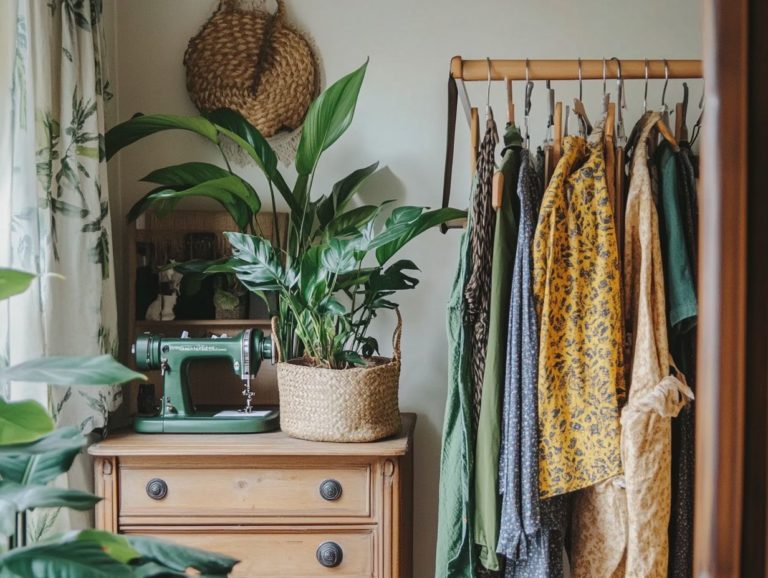5 Best Practices for Sustainable Wardrobe Maintenance
In a world increasingly aware of its environmental footprint, embracing sustainable fashion is a necessity.
This article explores five essential practices to help you build a wardrobe that is both stylish and eco-friendly. From investing in timeless pieces to adopting responsible shopping habits and making thoughtful fabric choices, you ll discover actionable steps that can make a real difference.
Learn how to care for your garments and creatively repurpose beloved old favorites, ensuring your wardrobe remains sustainable and chic for years to come.
Contents
- Key Takeaways:
- 1. Invest in High-Quality, Timeless Pieces
- 2. Take Proper Care of Your Clothes
- 3. Practice Responsible Shopping Habits
- 4. Repurpose and Recycle Old Clothes
- 5. Educate Yourself on Sustainable Fashion
- What Is Sustainable Fashion and Why Is It Important?
- Frequently Asked Questions
- What are the 5 best practices for sustainable wardrobe maintenance?
- Why should I wash my clothes in cold water for sustainable wardrobe maintenance?
- How does air drying clothes contribute to sustainable wardrobe maintenance?
- Why should I avoid dry cleaning for sustainable wardrobe maintenance?
- How does repairing clothes instead of replacing them help with sustainable wardrobe maintenance?
- What should I do with unwanted clothes for sustainable wardrobe maintenance?
Key Takeaways:

- Invest in durable, timeless pieces for a wardrobe that lasts longer.
- Properly caring for your clothes, like washing on cold and air drying, extends their lifespan and reduces waste.
- Practice responsible shopping habits, such as buying from ethical and sustainable brands, to support a more sustainable fashion industry.
1. Invest in High-Quality, Timeless Pieces
Choose high-quality, timeless pieces. This helps you build a sustainable wardrobe that lasts and combats the harms of clothing made quickly and cheaply.
This smart choice not only helps our planet but also adds style to your closet. When selecting eco-friendly clothing made from natural materials, consider brands like Levi Strauss & Co. and ADIDAS, which prioritize ethical practices and sustainability.
These companies demonstrate that stylish and durable fashion can coexist with respect for both workers and the planet. By focusing on quality over quantity, you can make mindful purchases that foster a more responsible lifestyle.
Ultimately, you ll positively impact your well-being and the environment.
2. Take Proper Care of Your Clothes
Caring for your clothes is crucial for extending their longevity and ensuring your sustainable fashion choices reduce waste and environmental harm.
Washing in cold water preserves fabric colors and prevents shrinkage, while gentle cycles minimize wear and tear. It s equally important to dry your garments properly; air drying saves energy and maintains the fabric s shape while avoiding damage from high heat.
Use padded hangers and breathable garment bags to protect your delicate items. Additionally, embrace eco-friendly products like biodegradable detergents and natural fabric softeners, which positively influence both the environment and your clothing’s integrity. For those looking to refine their style, following 5 essential tips for capsule wardrobe success can also be beneficial. These practices are essential for extending the life of your wardrobe.
3. Practice Responsible Shopping Habits
Practicing responsible shopping habits is vital for becoming a conscious consumer, enabling you to make informed choices that minimize the impact of fast fashion and promote ethical practices in the clothing industry.
By carefully selecting where to shop, you can significantly reduce your carbon footprint. For example, buying second-hand clothes from platforms like thredUP or Poshmark leads to unique fashion finds and extends the lifecycle of garments, cutting down on waste.
Supporting sustainable brands that prioritize eco-friendly materials and fair labor practices ensures your purchasing power contributes positively to the environment and society.
Understanding the environmental impact of your clothing choices fosters mindfulness, encouraging you to invest in quality items that align with your values instead of succumbing to fleeting trends. Consider incorporating essential clothing items for sustainable wardrobes to make a positive change.
4. Repurpose and Recycle Old Clothes

Repurposing and recycling old clothes extends their life cycle while playing a crucial role in reducing textile waste. Make a significant impact today by participating in effective recycling programs and donating to organizations like Goodwill and the Salvation Army.
If you’re feeling creative, consider turning those old garments into stunning fashion items or unique home decor. Imagine transforming a worn denim jacket into a stylish tote bag or using vintage scarves to craft decorative pillow covers.
Embracing the charm of vintage clothing adds character to your wardrobe and promotes a sustainable lifestyle. By opting to repurpose instead of discard, you contribute to a circular economy, which means reusing materials to create new products, thereby reducing waste.
Engaging in these practices benefits the environment and provides a sense of accomplishment and personal style. This can inspire others to join you in this rewarding journey.
5. Educate Yourself on Sustainable Fashion
Educating yourself on sustainable fashion is vital for grasping the ethical labor practices and standards that underpin the industry. This knowledge empowers you to make informed choices that support responsible brands and initiatives like Fashion Revolution and the Global Organic Textile Standard.
Explore various resources to enhance your journey. Insightful books delve into the history and impact of fashion, while thought-provoking documentaries unveil the hidden stories behind garment production. Online courses also offer structured learning opportunities, allowing you to engage with expert knowledge at your own pace.
Consider specific certifications like the Global Recycle Standard and Fair Trade, which can guide you in identifying brands that genuinely embody sustainable practices.
This exploration helps you grasp sustainable fashion concepts and encourages you to advocate for responsible practices within your community.
What Is Sustainable Fashion and Why Is It Important?
Sustainable fashion embodies a transformative movement focused on addressing the environmental impacts and ethical practices within the clothing industry. It emphasizes the necessity for reduced carbon emissions and responsible sourcing, striving for a more equitable future for both consumers and producers.
This approach aims to revolutionize the entire lifecycle of clothing how it’s produced, marketed, and consumed fostering a healthier planet. It plays a crucial role in tackling pressing issues like pollution from textile manufacturing and labor exploitation in developing countries.
By championing eco-friendly practices such as utilizing organic materials and adopting circular economies, this movement invites you to reconsider your relationship with fashion. Influential advocates like Livia Firth, co-founder of Eco Age, tirelessly promote sustainable practices, raising awareness and inspiring meaningful change within the industry.
Organizations like Eco Age are essential in this endeavor. They provide certifications and guidelines that empower brands to operate responsibly while prioritizing ethical values.
How Can One Determine If a Brand Is Sustainable?
To determine if a brand is truly sustainable, evaluate its commitment to ethical practices, transparency, and adherence to recognized standards like Bluesign. Check ratings from platforms such as Good On You.
It’s crucial to consider key indicators like responsible material sourcing, labor practices, and environmental certifications. These factors collectively paint a picture of a brand’s overall sustainability.
For instance, brands like Patagonia illustrate their dedication by using recycled materials and ensuring fair labor conditions throughout their supply chain. Similarly, Everlane stands out by emphasizing transparent pricing alongside ethical production processes.
By examining these indicators, you gain valuable insights into a brand s sustainability efforts. This helps you make choices that align with your values while positively impacting the planet.
What Are Some Sustainable Fabric Options?

Choosing sustainable fabric options is essential for minimizing your environmental impact. Natural components like organic cotton, linen, and hemp align with standards such as Standard 100 and ensure that what you wear is eco-friendly and safe.
These fabrics help reduce reliance on harmful pesticides and synthetic materials. They also promote healthier ecosystems. If you re looking to cultivate a sustainable wardrobe, incorporating these eco-friendly textiles can significantly lower your carbon footprint.
Certifications like GOTS (Global Organic Textile Standard) and OEKO-TEX provide assurance that materials meet rigorous environmental and social criteria. By opting for these responsibly sourced fabrics, you support ethical practices and encourage a shift towards a more sustainable fashion industry.
Your choices contribute to working together for a significant positive impact on the planet.
How Can One Make Their Current Wardrobe More Sustainable?
Transforming your current wardrobe into a more sustainable one requires embracing the philosophy of quality over quantity. Focus on eco-friendly clothing that embodies sustainable principles.
To make the transition, begin by decluttering items that no longer serve you or are remnants of fast fashion. This not only creates space but also enhances your ability to make clear and intentional decisions regarding future purchases.
Investing in versatile pieces that mix and match effortlessly is essential. Consider timeless staples, such as a classic white shirt or well-fitted jeans that will never go out of style.
Exploring sustainable brands that prioritize ethical practices provides a responsible alternative. Mindful shopping encourages you to make thoughtful selections that consider environmental impact while supporting 5 essential tips for building a minimalist wardrobe committed to sustainability.
What Are the Benefits of a Sustainable Wardrobe?
A sustainable wardrobe brings a wealth of benefits. These include a marked reduction in your environmental footprint, greater longevity of your clothing, and a meaningful contribution to ethical labor practices within the fashion industry.
When you invest in high-quality, timeless pieces, you’re not just enhancing your style; you’re also setting yourself up for significant financial savings over time. These enduring items outlast fast fashion alternatives that often require repeated replacements.
By choosing to support ethical brands that emphasize fair wages and environmentally friendly materials, you align your personal values with your purchasing decisions. There s profound emotional satisfaction from making responsible choices, instilling a sense of pride in your contributions to social and environmental causes.
This approach sparks a thoughtful engagement with fashion that can change lives!
How Can One Encourage Others to Adopt Sustainable Wardrobe Practices?
Encouraging others to embrace sustainable wardrobe practices can create a ripple effect, transforming the community’s perception of fashion and fostering a culture of conscious consumerism, similar to initiatives led by Fashion Revolution.
By sharing valuable resources like articles, documentaries, and local eco-friendly brands, you can ignite interest in sustainable fashion choices. Additionally, organizing engaging events such as clothing swaps revitalizes your wardrobe without adding to waste while strengthening community ties. For those looking to keep their styles fresh, learning how to maintain your essential clothing items can be incredibly beneficial.
Advocating for eco-friendly clothing options invites family and friends to explore alternatives that reduce environmental impact. Additionally, knowing how to care for your sustainable clothes can extend their life and effectiveness. Utilize social media to spark discussions amplifying your message, reaching a broader audience and inspiring collective action.
Engaging with local influencers can further reinforce these initiatives, encouraging even more people to join the movement toward sustainability.
Frequently Asked Questions

What are the 5 best practices for sustainable wardrobe maintenance?
The 5 best practices for sustainable wardrobe maintenance are: washing clothes in cold water, air drying clothes, avoiding dry cleaning, repairing clothes instead of replacing them, and donating or recycling unwanted clothes.
Washing clothes in cold water saves energy and reduces harmful gases. Hot water uses more energy and can damage certain fabrics, leading to premature wear and tear.
Why should I wash my clothes in cold water for sustainable wardrobe maintenance?
When you wash your clothes in cold water, you save energy and reduce harmful gases. Hot water uses more energy and can damage certain fabrics, leading to premature wear and tear.
How does air drying clothes contribute to sustainable wardrobe maintenance?
Air drying clothes eliminates the energy used by a dryer, reducing your carbon footprint. It helps preserve the quality of clothes since dryers can cause shrinkage and fading.
Why should I avoid dry cleaning for sustainable wardrobe maintenance?
Dry cleaning involves the use of harsh chemicals that can harm the environment. It requires energy and produces waste. Why not try hand washing or using a gentle cycle instead? Your clothes will thank you!
How does repairing clothes instead of replacing them help with sustainable wardrobe maintenance?
Repairing clothes not only saves you money but also reduces the amount of clothing that ends up in landfills. By extending the life of your clothes, you are actively reducing your environmental impact.
What should I do with unwanted clothes for sustainable wardrobe maintenance?
Act now! Donating your clothes not only helps you declutter but also supports those in need. Instead of throwing away unwanted clothes, donate them to a thrift store or clothing donation program. This reduces textile waste and gives your clothes a second life. You can also recycle old clothes into new items, such as cleaning rags or tote bags.






